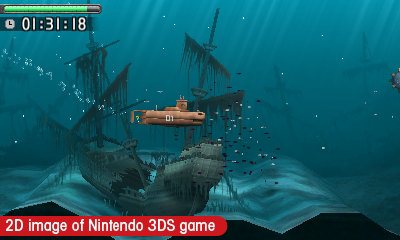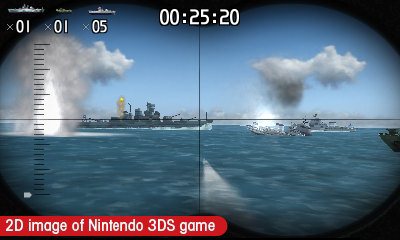unique and innovative controls, fun use of the gyroscope, single-card multiplayer, some nice 3D effects
slowly paced, steep difficulty curve, little variation in content
Steel Diver is placed in an unenviable position. As the only non-sequel in Nintendo’s first-party 3DS launch line-up, there are certain expectations for the game that it cannot possibly meet. That company faces like Miyamoto and Reggie have been publicly touting the game is also a double-edged sword, since many who decide to purchase this title solely on those words of praise will undoubtedly be let down by unrealistic (or uninformed) expectations of the game. Further, Steel Diver began life as a tech demo for the original DS, and this genesis is readily apparent in the final product. Still, that is not necessarily a bad thing, and gamers who know exactly what they are getting into will find a lot to enjoy in the title.
At its heart, Steel Diver is three different games tied together by the same motif. The first is the campaign, a collection of side-scrolling underwater obstacle courses through which you must carefully navigate. There are a total of seven different “missions” to complete (the final two of which must be unlocked), in addition to eight separate time trial courses to tackle. Players are given three unique submarines from which to choose– each roughly the equivalent of a different difficulty setting– and must clear every stage with all of them to open up the final pair of missions. Each stage ends with a brief game of Periscope Strike (which will be elaborated on in greater detail below) that allows you to amass decals for your ships. These stickers imbue your vessels with unique attributes (halving damage, increasing your recovery rate, etc.), but only a single one can be applied to your submarine per mission. You are rated on your performance at the end of each stage, but (perhaps thankfully) your rank is determined solely by your completion time. Those who enjoy continually improving their own high scores will derive a lot of fun from the title (especially in time trials, where you can race against developer ghosts), but everyone else may not find the same appeal in replaying a handful of missions with no real reward.
The controls for this particular mode are the title’s most unique and innovative feature. Each submarine is piloted entirely via a pair of levers on the touch screen. The horizontal one is responsible for forward and backward movement, while the vertical controls diving and surfacing. The two more difficult ships also have a wheel with which you control that vessel’s pitch, and this must be used in conjunction with the aforementioned levers in order to successfully steer through the title’s myriad obstacles.
The first pair of missions gently illustrate the title’s mechanics in action, but each subsequent one becomes increasingly difficult to navigate. Some of the later stages can prove very frustrating, especially when piloting the two more difficult submarines, and this will undoubtedly deter many gamers from the title. That said, mastering the controls feels very rewarding in its own right, and there is a palpable sense of satisfaction when you successfully navigate through an underwater cave with minimal damage taken.
The stereoscopic effects are quite subtle in this mode, but they are neat just the same. 3D adds a noticeable level of depth to the backgrounds, making them appear to stretch into the horizon. It almost feels as though you are looking into a fish tank, and while the effects do not affect the gameplay in any way, they are still fun to behold.

Periscope Strike is the second game and is much more immediately accessible than the campaign missions. This particular mode is played from a first-person perspective, and your objective is to destroy every enemy vessel in the vicinity as quickly as possible. You must physically rotate the system left and right to scour the ocean (much like how you would locate adversaries in Face Raiders), which is a lot of fun and is arguably the biggest appeal of the mode. Unlike the campaign, however, you are not rewarded with decals for every vessel sunk; rather, the only reason to play this game is to best your previous clear time. The mode features three different “stages,” but these essentially amount to changes in scenery– the first, for example, is the ocean in clear weather, while the second is the same setting but during a thunderstorm. The last stage, however, offers a slight variation in challenge– because this one is set underwater, your vision is obscured, and you must rely on your sonar to locate every last enemy ship. None of the stages are even remotely difficult (and there is no real punishment for getting struck by enemy fire), but they are all still fun and are perfectly suited for quick, pick-up-and-play gaming sessions.
The title’s stereoscopic effects are far more impressive in this particular mode. It really does feel as though you are peering out over an endless expanse of water, and the spatial distance between yourself and each enemy ship is much more clearly defined as a result. The effects are especially convincing in the stormy setting– waves crash and undulate around the eyes of your periscope, drawing you into the center of the maelstrom like never before. It really is a sight to behold, and while the game may not rank among the most graphically or artistically impressive on the console, effects such as these mask any polygonal shortcomings it may have and greatly enhance the overall experience.

Steel Commander is the last mode and is the title’s multiplayer option, a turn-based strategy affair similar in premise to the board game Battleship. Players are given command of a small fleet of vessels, and they must navigate their submarines into enemy waters and destroy their opponent’s supply ships to end the battle. Each enemy vessel is initially invisible on the control grid, so players must use their submarine’s sonar to reveal the location of any nearby ships. The catch, however, is that doing so reveals your location as well, allowing your opponent to either launch a preemptive attack or reposition one of their units. Further complicating the game is the fact that only a single action can be undertaken per turn, forcing players to make risky sacrifices and prioritize their every movement.
There are a handful of maps on which to play, but the mode’s biggest strength is the fact that it supports single-card multiplayer. This allows for a much greater range of opponents as only one gamer needs to have a physical copy of the title to initiate naval battles. Those without 3DS-owning friends can still enjoy Steel Commander in single-player, but the mode shines its brightest when played against an actual human being. The enemy AI is not particularly difficult to trick, so the real fun and challenge of the game stems from trying to outwit a sentient opponent. Still, even in single-player the mode is a fun and welcome inclusion, and it greatly helps extend the title’s longevity.
Steel Diver is certainly a fun title, but it will not appeal to everyone. The learning curve in Mission mode is quite steep, and many will undoubtedly be put off by the slow pace at which each stage unfolds. Periscope Strike and Steel Commander are both immediately more accessible and a lot of fun, but each is comparatively shallow in terms of content and may quickly bore those looking for more of a challenge. Despite the title’s best efforts, its roots as a tech demo are clearly visible in every facet of the final product, and while there is a lot of fun to be had, the scant amount of content it offers makes it difficult to fully justify its cost of entry.




 ShareThis
ShareThis






ARGH C+ I had read reviews at other sites, too, and it turns out the same way. I had high hopes from this first-party title, but the short length definitely turns me off.
off off off
Yeah, it’s length is definitely the biggest strike against it. It would be a lot easier to recommend if it went for about $20.
I have played it for all of two minutes, so I’m not exactly the best judge, but the demo felt very clunky, very unresponsive. And if that’s supposed to be the most gripping, engaging part of the experience then I would have doubts.
Turns out submarines aren’t fun.
Submarines ARE clunky, though. To me, it definitely felt better than what this long review has to say about it as well as others. I give it an 8/10. It wasn’t mentioned in this review, but the game is really meant for playing in chunks. You pick it up and play a mission and then go on with your life until the next couple of free minutes you have.
Periscope mode really makes great use of 3D as well and is probably some of the most fun and new experiences I’ve had in a while. Very fresh.
Re: submarines clunky; Yeah, but swordplay gives you vibrations down your arm, throws you off balance on a bad strike, and generally feels horribly unpleasant– but Twilight Princess didn’t simulate all of that!
(Looking forward to periscopin’ though.)
I think just the fact that the both of you have such different impressions of the title illustrates how difficult it was to objectively rate it. The controls certainly take some getting used to, but as I mentioned I actually enjoyed them; the problem is that many others will not, and there is no incentive to stick with them unless you really enjoy replaying the same missions. I also could not fully recommend it to those who like pick-up-and-play kind of games because Pilotwings Resort is built upon that same philosophy and succeeds much better at it.
Periscope Strike is a lot of fun and was perhaps the main reason I bought the game, but it does not take long to realize it is very similar to Face Raiders, which actually comes preinstalled in the system (and not to mention actually offers more content). Overall I do think it is a good game, but it has very limited appeal and is not worth its full price tag.